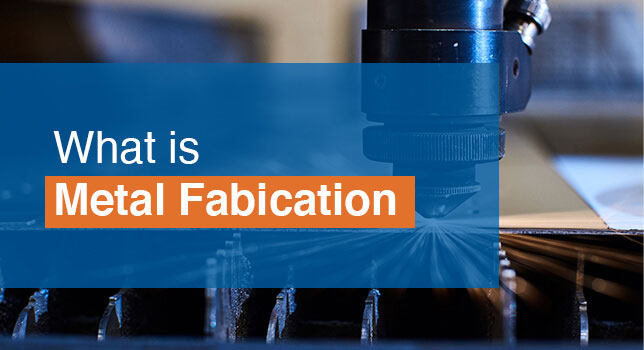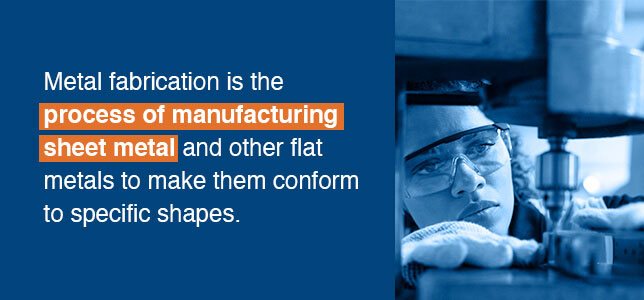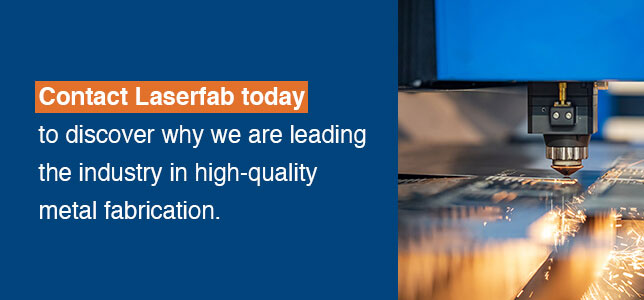What is Metal Fabrication?

Every time you get in a car, pick up the phone, handle a tool or turn on an electronic appliance, you are looking at the result of custom metal fabrication.
Our economy relies on metal fabrication processes. Without it, we wouldn’t be able to run our electrical systems or create the parts that keep our houses, kitchens, businesses, computers and vehicles operational. Some fabricated metal product examples include bolts and screws, cutlery, pipe fittings, car parts and even hand tools. However, it is difficult for many of us to understand what precision metal fabrication entails, as well as all of the areas of our lives it affects.
This article will serve as a metal fabrication guide, explaining metal fabrication’s definition, history, process, technology, types and applications. By the end, you will have a more in-depth understanding of how crucial this process is to civilization and how many different parts of our lives it touches.
Metal Fabrication Definition
Before we dive into the details of what metal fabrication is all about, we have to answer the main question: what is metal manufacturing and fabrication?

Metal fabrication is the process of manufacturing sheet metal and other flat metals to make them conform to specific shapes. The process starts with sheet metal around a quarter of an inch thick or less. At this thickness, the metal is pliable enough to assume different shapes. Using this metal, fabricators alter the sheet to create a specific shape. This takes place through cutting, stamping, shaping, folding and welding. Another related practice is custom fabrication, meaning the creation of new custom parts using novel combinations of these processes.
All this work is completed by metal fabricators — highly skilled specialists who are trained to cut and manipulate metal with a surgeon’s precision to the desired shape. These fabricators often work out of large-scale manufacturing operations or specialized fabrication shops. The shops themselves vary widely, offering general fabrication services or specialized fabrication for medical and IT industries.
Metal fabrication may require additional parts to be added during the process, including but not limited to:
- Plate metal
- Expanded metal
- Formed metal
- Wire for welding
- Hardware
- Fittings
- Castings
Of course, the processes and parts used will vary depending on the job. Essentially, a fabrication shop or machine shop will start with a collection of assorted metals and transform them into the tightly built structures so common in our everyday lives.
The History of Metal Fabrication
Humans have been mining and machining metal for the past 10 millennia, as evidenced by a copper pendant archaeologists found in northern Iraq that dates back to about 9,000 BCE. Fabrication shops as we know them today began to exist around the Industrial Revolution, when sheet metal was in much higher demand than before. The invention of the hydraulic press, which allowed manufacturers to apply unprecedented pressures to pieces of metal, transformed the metal fabrication industry.
Metal fabrication on a broad scale was necessary to form systems of railroads, telegraph lines, weapons, tools, printing presses and other implements that have been so instrumental in our history. All of these advances relied on machine shops performing joints, cuts, bends and forming operations, just as is done today. The advent of compressed air has made riveting, another important part of fabrication, much easier and more efficient.
With the onset of the 20th century, metal fabrication has assumed an even larger role in our lives. We now perform machining on grand scales, ranging from small, family-run operations to large manufacturing plants employing thousands of people.
Technology Used for Metal Fabrication
While metal fabrication has existed in some form for millennia, the practices and technology have evolved significantly over time. Many of the basic processes have been around for centuries, but there are significant innovations that have revolutionized how we fabricate metal products in the modern world. Some of the most significant types of metal fabrication technology that are now at the forefront of the fabrication process include:
- CAD software: Computer-aided design (CAD) software plays a significant role in the design of metal fabrication projects. Engineers use CAD software to develop designs, which can then be used by a fabrication company in the fabrication process. This software system allows for the production of 3D models as well as quick updates and changes to the design. CAD software also facilitates easy translations to programming language for programming fabrication machinery. Computer-aided design has made parts much easier to fine-tune, and it allows engineers to figure out crucial information instantaneously, including information on spots that may be structurally weak.
- Automation: Automation has revolutionized the fabrication process in recent years. Fabrication machinery is increasingly being produced with programming capabilities, allowing the machinery to automatically complete projects to specifications with minimal human involvement. This allows for round-the-clock work, as well as improved reproducibility and precision. Automated tools are available for a wide range of processes, including cutting, welding, folding and various machining processes.
- Machinery: Machinery solutions are also improving over time. Laser technology is being used in cutting processes, which allows for faster cutting through thicker materials. Other technologies, including plasma cutting and waterjet cutting, are also increasingly available. These methods are valuable for a range of different project and material types.
These technologies are expected to expand in the coming years, especially as fabricators push for greater flexibility in their equipment.
Types of Metal Fabrication Processes
There are various processes involved in metal fabrication. The specific combination of metal or stainless steel fabrication processes will vary with the geometry of the part, the type of usage it will get and what it is made of. Here are examples of some choices for different types of fabrication processes:

- Cutting: Cutting is the most fundamental process in metal fabrication, and it can be accomplished through laser cutting, waterjet cutting, shearing, sawing or flame cutting. This is what turns the sheet metal into a piece of the required size and shape. Today, waterjet and laser cutting comprise the foremost technologies available.
- Casting: A die forms a mold, and the fabricator pours molten metal into it. This metal cools down and turns solid, and the part remains after removing the die.
- Forging: High-pressure machinery compresses raw metal, allowing a fabricator to bend and shape it.
- Punching: Turrets punch pre-designed patterns into the metal, either for decorative purposes or utility.
- Drawing: This process uses tensile force to pull liquid metal into a tapered die.
- Milling: A milling mechanism bores perforations into the metal, which, due to the nature of the machine, can be non-circular.
- Drilling: A drill cuts holes into the metal using a circular bit.
- Turning: The piece of metal goes onto a spinning platform, allowing a technician to cut it radially with a tool as it spins.
- Extrusion: A ram forces billets through a die. This extrusion process forms cylindrical parts, such as pipes or electrical wires.
You will often hear these metal fabrication terms used during the planning stages of the metal fabrication process, so it is essential to familiarize yourself with these common processes and some of the machinery involved.
How Different Metals Are Fabricated
Metal fabricated products are created from a broad range of metals and their alloys. While most fabrication processes start with sheet metal versions of these metals, certain types of metals may start in the form of pipes, tubes or bar stock.
Below are a few of the common types of metal used in metal fabrication:
- Aluminum
- Steel
- Copper
- Tin
- Gold
- Magnesium
- Iron
- Silver
- Nickel
Most metals are available in stock metal forms, which typically include sheet or plate metal, bars, rods, fittings or wires. Metals like steel and aluminum may also be available in pipe or tube form, depending on the needs of the project. Precious metals, such as gold and silver, tend to be available in smaller wire, sheet or bar forms due to their value.
Most metals can also undergo a majority of fabrication processes, though limitations exist depending on the softness, pliability and thickness of the metal. For example, the rigidity of steel will affect the types of processes and amount of power needed for steel fabrication, meaning the processes will look different than it would for fabricating a more pliable metal like aluminum. To learn more about the different process requirements for a certain metal, reach out to a specialist in metal fabrication services.
How Does Custom Metal Fabrication Work?

Metal fabrication starts with an idea, typically born out of necessity, that involves a piece of metal suited for some particular task. For example, a tech company may need a machined aluminum case for a new gadget. Once they have the idea, companies will design the part and send it out to several machine shops as part of a request for a quote. The machine shops analyze the schematic, calculate the cost of production and reply with both cost and lead time.
At this point, the company chooses the machine shop they wish to work with. The shop then puts the order in their queue and sets about ordering materials for the machining job. This may consist of sheet metal, metal bars, metal rods and more. As soon as the parts arrive and the job is in the queue, the team sets to work building the part itself.
The full process for custom metal fabrication is described step-by-step below:
- Design: The design phase involves analyzing and adjusting the design for manufacturing. While this step is often completed solely by the customer for more standard parts, the fabrication service provider is often involved for custom projects. During this phase, the manufacturer’s design team works with the customer to determine project requirements, manufacturing approaches and areas of improvement and uses CAD software to produce designs.
- Prototyping: Prototyping is a common next step, though it isn’t necessary for every project. In this phase, a rapid prototype is produced using either 3D printing or rapid sheet metal prototyping. The prototype is then analyzed for feasibility, and the customer and design team can identify any adjustments that need to be made to the design before moving on to the next stage of production.
- Programming: As soon as the CAD design for the product is finalized, it is translated into programming for any computer-controlled machines that will be involved in the fabrication process. Programming is often required for automated cutting, punching and turning machines.
- Fabrication: After programming is complete, the fabrication process begins. The time it takes to fabricate depends on the complexity of the part, the processes involved and the demand on the machine shop. The fabrication process itself may include various steps, including cutting, punching, folding, machining, welding and more.
- Finishing: Once the fabrication process is complete, the fabrication service may finish the product. This often includes refining surfaces and edges or applying various coating options, such as powder coating.
- Assembly: Some fabrication services also offer assembly, which may involve welding or electrical integrations.
Why You Should Outsource Metal Fabrication
While some companies may have the capability to handle metal fabrication in-house, most companies don’t have the in-house machinery and expertise to accomplish this. Fortunately, outsourcing metal fabrication to a third party is an available option and presents significant benefits to companies with metal fabrication needs. Some of the common benefits of metal fabrication outsourcing include:
- Expertise: Metal fabrication services are dedicated to their craft and focus on studying the latest trends, technologies and practices in the field. They also employ experts in fabrication who have extensive experience they can deliver to your project.
- Consulting: An outsourced metal fabrication service can act as your partner, helping your company by reviewing custom project designs for manufacturability. This expert can be an extra set of eyes to help identify innovative design modifications, and they can help reduce costs by identifying areas of improvement that can decrease manufacturing and material expenses.
- Resources: Metal fabrication services already have the tools on hand to achieve any project you need. They also invest in the latest technology, ensuring your project is benefitting from advanced tools and techniques.
- Quality: The expertise, consulting services and technologies available from outsourced metal fabrication services can help your company achieve maximum quality with every project.
- Cost: Outsourcing your custom metal fabrication projects means your company doesn’t need to invest in costly equipment or maintain an expert workforce. By outsourcing your metal fabrication, you can avoid these costs while also leveraging your fabrication partners’ expertise and capabilities to maximize quality while reducing expenses.
When choosing a metal fabrication service, look for experienced companies with good resources and experience working with your industry or related fields. If you’re looking to outsource your metal fabrication services, Laserfab is here to help.

Learn More About Laserfab’s Metal Fabrication Services
Our metal fabrication services prioritize three factors: price, quality and delivery. While many companies excel in one or two of these qualities, Laserfab understands true value is about treating all three equally.
It all starts with filling out our Request for Quote form. We take every step possible to ensure the lowest price with the highest quality. You’ll receive your quote quickly, allowing you to make the most of your time.
Our production involves state-of-the-art equipment in a high-grade, professional facility that employs some of the industry’s best engineers and technicians. As soon as we finish your product, we will deliver it to your doorstep when you need it.
Contact Laserfab today to discover why we are leading the industry in high-quality metal fabrication.
